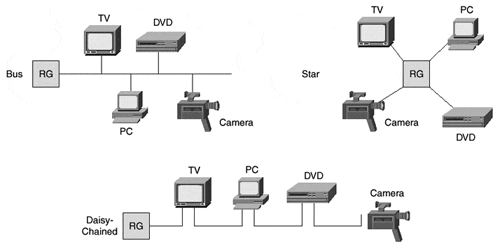Topology Alternatives
Finally, the Home Network architecture should consider topology alternatives. Some of the proposed Home Networks operate as a bus, some in a star configuration, and some daisy-chained. These configurations are depicted in Figure 7-3.
Figure 7-3. Home Wiring Topologies

The bus configuration provides economic use of wiring, requires only a single network connection per device, and is well-suited to the broadcasting case. On the other hand, this configuration requires bandwidth arbitration, and demultiplexing is advised. Furthermore, because the bus is a shared infrastructure, it is susceptible to impairments caused by malfunctioning equipment. For example, if the PC begins to spew extraneous signals, the TV could be adversely affected.
The star configuration isolates traffic per device and therefore can guarantee bit rate per device. This is good for video and for problem isolation. Furthermore, a malfunctioning device would not adversely affect other terminal equipment. In some situations, however, such as broadcast video, broadcast is useful. In this case, packets must be replicated, which creates a processing burden and necessitates the greatest amount of wiring. Finally, a star configuration requires the use of a switch so that packets can exit onto the correct interface. This increases total system cost and introduces an active single point of failure.
Unlike the bus and star configurations, daisy chaining is not common in the commercial LAN world except as a means to connect peripherals to a single computer. This configuration involves the minimum amount of wiring but requires two ports per device. Daisy chaining is similar to the bus but does not require preprovisioning.
